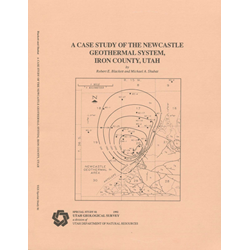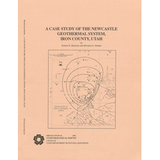A case study of the Newcastle geothermal system, Iron County, Utah (SS-81)
By: R. E. Blackett and M. A. Shubat
Past exploration in low- and moderate-temperature systems of the Great Basin shows that the relatively small area associated with fluid upflow and elevated temperatures is often difficult to detect by drilling widely spaced temperature-gradient holes or by other methods. By studying the Newcastle geothermal system, we hoped to develop a basic understanding of the concealed hydrothemlal system as a tool for assessing other geothermal areas of the Great Basin.
The emphasis of our work centered on determining (1) the distribution of subsurface heat and the movement of thermal fluid, (2) the location and geometry of bedrock structures that might control fluid movements, (3) the chemical character of the geothermal water, and (4) the geometry of the bedrock beneath the Escalante Desert. Field studies included: (1) drilling and monitoring temperatures in shallow themlal-gradient boreholes, (2) mapping geologic units and performing structural studies in the adjacent mountains, (3) conducting detailed gravity surveys, (4) conducting electrical resistivity and self-potential (SP) surveys, (5) collecting water samples for detennining major ions and light stable isotope analyses, and (6) mapping Quaternary units.
Other Information:
Published: 1992
Pages: 30 p.
Plates: 2 pl.
Scale: 1:24,000
Location: Iron County
Media Type: Paper Publication







